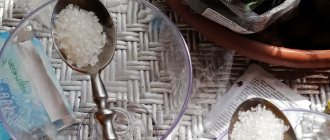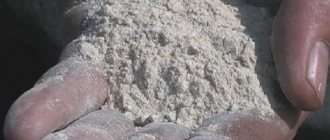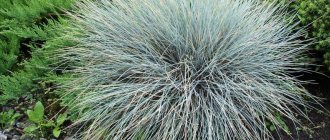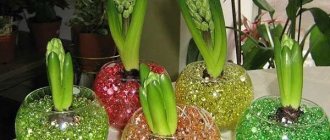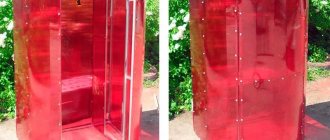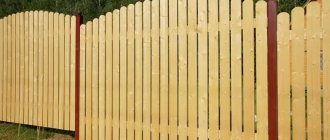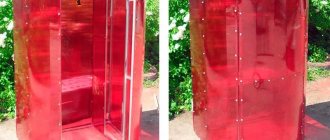How to use hydrogel for plants for indoor and garden plants and growing technology will be described in this article. Science does not stand still, and it has also introduced its innovations into the field of gardening. Scientists have invented a product called hydrogel, which helps retain moisture in plants. In this case, the task of water is entirely aimed at feeding the root system. At the same time, a normal fluid balance is always maintained in the soil.
Some summer residents have already realized the effectiveness of this product and continue to use it. However, there are gardeners who have heard of hydrogel, but know little about it. In this article you will get acquainted with all its properties, characteristics, beneficial qualities and disadvantages, and also learn the technology of growing plants with hydrogel .
Hydrogel for plants: what is it?
From a chemical point of view, a hydrogel is a polymer that can absorb and retain a certain volume of liquid, including nutrient solutions. 1 g of gel can absorb about 0.2-0.3 liters of water. In other words, hydrogel for plants in dry form increases 200-300 times if it is saturated with liquid.
To put the product to work, it should be applied under the plant where the root system is located. Typically, the substance is first soaked in water and then introduced into the soil. If it was sprinkled dry, then the area must be immediately watered abundantly.
Within 15-20 days, the roots will grow through the capsules with the substance and begin to feed on moisture from there. Even if the area has not been watered for a long time and the soil is completely dry, the root system will not be damaged in this case. The plant will not die thanks to the fluid reserves that the hydrogel will provide it with.
The product is very convenient to use if there is a dry summer or summer residents rarely visit their dacha. In addition to water, granules can be filled with liquid fertilizers. Then, with rare care of the plant, it will not only not suffer from lack of water, but will also be fed on time.
The special properties of the hydrogel can maintain normal soil moisture. It collects all the remaining unused water, which the plant will consume as needed.
Effect of use
Using this material, you can solve many problems associated with growing indoor and garden plants and seedlings. Thus, plants in this composition do not suffer from drought.
The watering interval can be reduced from 2 to 6 times, depending on the planted crop. Garden plants that grow in containers can go without watering for a week. And indoor plants can be left without watering for 2-3 weeks, depending on the type of plant and the temperature of the room where the pot is located.
The hydrogel has the ability to retain not only moisture, but also nutrients. Fertilizers are not washed out of the soil . The roots in such a gel can breathe freely, and this accelerates the growth rate of the plant and improves its flowering and fruiting. Using such material, you can also improve the plant’s resistance to various stresses and infectious diseases.
As a result, it should be noted that such material is quite useful both for the plant and for the grower himself. Before using such a product for growing crops, you should study the instructions, which indicate how to use the hydrogel for plants.
Hydrogel and aqua soil - what's the difference?
Do not confuse this hydrogel with a completely different material - Chinese aquasoil, which is also called hydrogel. Despite the fact that they have a similar polymeric nature, their tasks are different. Hydrogel capsules serve as a reservoir for accumulating water, and aqua soil is intended more for decorative purposes.
Manufacturers often produce aqua soil in the form of colored balls. In water they swell and acquire a transparent and beautiful appearance. Sometimes on the market such a product is called an agronomic hydrogel, which has all its advantages. Buyers need to be more careful.
Beautiful granules have only decorative properties. They are not able to help plants. With their help, flower growers create wonderful compositions. You can find many options for such ideas on the Internet or come up with it yourself.
Features and Benefits
The gel is available in the form of granules or powder. Sold in packaged or dry form. This is a polymer that absorbs water well, while it expands several times.
On average, 1 gram of such a product can absorb almost a glass of water. As the soil dries, the gel releases water to the roots. It is believed that hydrogel for flowers should be in the form of balls, but this is not so. It was originally developed as a formless substance.
Hydrogel for indoor plants has both advantages and disadvantages. The advantages include the following aspects:
- high moisture absorption;
- the ability to maintain an optimal level of substrate moisture without frequent watering;
- efficiency;
- the composition provides all the necessary conditions for early seed growth;
- The gel retains all the useful microelements and vitamins and gradually releases them to the soil.
However, such a product has its drawbacks, which you should be aware of before using it to plant a houseplant. The disadvantages of this product are the following:
- crops whose seeds have a leathery shell cannot be grown in hydrogel;
- the composition is not compatible with all colors and crops;
- you need to monitor the temperature of the surface on which the flower with such a gel is located, as hypothermia is possible.
A decorative alternative to hydrogel is aqua soil, which is available in different shapes and colors. It is not added to the soil, since such balls do not decompose even over time. Advertising campaigns have endowed aqua soil with unusual abilities. Some advertisements indicated that the plant can be grown directly in aqua soil, but this is not the case. This kind of substitution caused a negative attitude towards aqua soil.
What happens?
This product is presented in the form of a dry powder. Solid crumbs with different shapes absorb water and increase in size by 200-300 times. The result is a mass of jelly-like consistency. Sometimes this material is used as a substrate. However, most often it is applied to the soil, where the roots of the plant penetrate the water-filled granules and take the required amount of moisture.
Liquid hydrogel can also be found on sale. In terms of appearance, it is no different from agricultural hydrogel. However, after adding liquid, the granules do not swell, but dissolve in water. Typically, this substance is used to wet the seeds before planting them in the ground.
This method makes it possible to speed up seed germination. Seeds cannot be germinated directly in liquid hydrogel. The substance envelops them, blocking the access of air. Therefore, seedlings may either die or take a long time to germinate.
What domestic crops are used in growing?
Hydrogel is an excellent additive for flowers that require frequent watering and is suitable for all plants that love a humid environment. For flowers with a rare watering regime, for which water is not the main priority for growth, its use is not recommended. The substance is absolutely not suitable for cacti and other succulents.
As for planting in pure hydrogel, ficus, dieffenbachia, ivies, arrowroot, dracaenas, philodendrons, syngonium, chlorophytum and ferns are suitable for this. Cacti, succulents and epiphytes are not suitable for such planting.
Advantages
- Using hydrogel when planting seeds, you can get seedlings 7-14 days earlier. At the same time, the crop yield increases significantly.
- By saturating the granules with liquid fertilizer, the plant will be provided with useful minerals for a long time.
- The soil in which the hydrogel is embedded has a loose structure, so the plant’s root system receives enough oxygen.
- The survival rate of seedlings in such soil is ensured up to 95-98%. Ornamental plants do not lose their original appearance until the end of the season.
- Beneficial from an economic point of view: 0.8-1.6 g of the substance is enough for 1 kg of soil.
Basic properties of aquagel
The main property of hydrogel is its water-holding ability. 1 g is capable of accumulating 300 ml of water along with the substances dissolved in it. As the surface layer dries, the particles return to the form of granules and remain active for at least 5 years. Aquagel does not cause any harm to the environment. The product, having served its term, decomposes in the soil into simple substances that are widespread in nature:
- water;
- carbon dioxide;
- ammonium.
Slowly being utilized in the soil, the drug becomes an additional source of nitrogen for plants and carbon dioxide necessary for their carbon nutrition during the period of crop formation. Used balls at home can be disposed of in the usual way, by placing them in trash containers.
How to use hydrogel for plants?
The substance should be added to the soil during its preparation, which must be done before planting the plant in trays, flower beds, etc. At the same time, it is necessary to comply with the standards for applying the substance. For garden and indoor plants growing in containers, add 1 g of dry hydrogel (about ¼ tsp) per 1 liter of soil. Or granules saturated with water are added in the following ratio: 1 tsp. gel for 5 hours of soil. The same set is used for growing seedlings.
Some gardeners use another method: add 1 cup of the swollen substance per 1 liter of soil.
The powdered hydrogel is poured with water and infused for an hour or more. When the granules take up water, the remaining liquid is drained. The gel is mixed with the soil evenly to fill all areas with capsules with reserve moisture.
After the soil has been prepared, seedlings can be planted in it. After 10-14 days, the roots will already penetrate the capsules and the plant will be able to receive enough liquid. Now the area can be watered 2-6 times less, taking into account the temperature and location of the plant.
Under planted plants
There is another method of using technology for growing indoor plants with hydrogel . The substance can be added to trays in which flowers are already growing. To do this, holes are made on the surface of the earth into which dry granules are placed. Water is poured into the holes. If the powder floats, you can sink it to the bottom and sprinkle it with 1-2 cm of earth.
Watch the video! Hydrogel. Features and use of hydrogel
Adding hydrogel to open ground
Upon landing
- When preparing areas for planting plants in open ground, dry hydrogel is used, after which they are thoroughly watered. At the same time, per 1 sq. m. take 25-100 g of granules. First, dig up the soil well, and then add dry matter and mix well.
- For plants whose root system is located close to the surface, dry granules are added to a depth of 10 cm. If the roots of the plant go deep, then the hydrogel is buried into the ground up to 20-25 cm. Then the area is well watered. After the granules are filled with water, the soil in this place rises.
- You can add the hydrogel directly to the hole prepared for planting. In this case, gel and primer are taken in a ratio of 1:5. First, the dry substance is filled with water. After swelling, it is placed at the bottom of the hole and mixed with soil. You can also use the method of layer-by-layer distribution of gel and soil. The roots of the seedling are placed in the hole and covered with soil mixed with gel.
Under planted plants
- The area in the middle of the projection of the crown of a tree or bush is pierced using a suitable tool (stakes, bayonets) to a depth of 15-20 cm. The dry hydrogel is placed at the bottom of the funnels and sprinkled with earth. Now the area needs to be well watered. After 40-50 minutes, it is advisable to water the plant again.
- Another method can be used. First, fill the granules with water. When the hydrogel swells, it must be evenly introduced into the top layer of soil to such a depth as to reach the roots. It is better to carry out this procedure with your hands, since the tool can damage the root system of the plant.
Sowing seeds in hydrogel
It is worth recalling another way to use a polymer substance - germinating seeds using pure hydrogel. Despite the fact that this method is not described in the instructions, many gardeners often use it.
Hydrogel consumption rates:
- For small flowers, dill, parsley, take 20-30 g of the substance in dry form per 1 square meter. The granules are applied to the soil when sowing seeds, after which they should be watered well.
- For radish seeds, 5-10 g of dry hydrogel should be used on 1 linear meter of land. One plant will need 0.2-0.5 g.
- Peas, carrots - 3-5 g of granules are added per 1 linear meter of strip at. For 1 plant – up to 0.3 g.
- For 1 beet bush you need 0.3 g of dry matter.
- For potatoes - up to 2-3 g of hydrogel per area with a radius of 15-20 cm. After this, be sure to water.
- For cucumber, watermelon, zucchini and pumpkin seeds you will need 0.5-1 g of dry matter per 1 square meter. When planting seedlings, 100-150 g of swollen granules are introduced. To prepare the finished gel, you need 10 g of dry matter per 2 liters of liquid.
- To grow tomatoes in a greenhouse, take 0.5-1 g of dry hydrogel or ready-made gel in an amount of 100-150 ml. (10 g of granules per 2 liters of water. Dry hydrogel is added to the bottom of the hole. Plant roots are dipped in the prepared gel and placed in the hole along with the remains of the granules.
- To sow lawn grass you need 50 g of dry matter per 1 square meter.
Before use, the hydrogel is soaked in water. The remaining moisture is drained off, and the resulting mixture is ground until fine. This homogeneous mass is distributed in a layer of 1-2 cm along the bottom of a wide container. Seeds are placed on top, easily pressing them into the gel. After this, the tray is covered with plastic film. When the first leaves appear on the sprouts, it is necessary to plant them in a permanent place along with the gel.
The hydrogel does not need to be thrown away after use. Place it in pots prepared for seedlings. When planting plants in open ground, place the remaining gel in the holes. During watering or rain, the hydrogel granules are replenished with moisture. 1 g of dry substances can absorb up to 200 ml of liquid. Therefore, plants do not need to be watered often.
Characteristics of hydrogel for plants
The hydrogel is available in the form of a colorless powder or crystals. Soaked in water, they absorb it, turning into a kind of reservoir of water. If you add hydrogel to the soil, it will swell and begin to supply moisture to the plants. Even after the soil dries out, the reserve reservoir (hydrogel) remains full, and the root system of the plants pumps out as much liquid as it needs.
The chemical formula of the hydrogel is a polymer (cross-linked copolymer) that holds water and fertilizers in solutions in large quantities. The hydrogel has the following absorbing abilities: 1 gram of dry matter absorbs up to 0.3 liters of liquid.
Characteristics and methods of using hydrogel.
Before use, the hydrogel is applied to the soil in places where plant root systems have access to it. It is best to apply a substance that is swollen and saturated with water, but it can also be dry (in this case, after adding the hydrogel, it is necessary to immediately water the soil abundantly).
It takes 2-3 weeks for plant roots to grow through hydrogel capsules . They then absorb water from the capsules without needing frequent watering. If watering is infrequent, the soil between them dries out completely, but this will not harm the root system of the plants. The hydrogel acts as a backup source of moisture that can water plants and prevent them from withering and drying out during severe drought and heat.
Hydrogel granules are saturated not only with plain water, but also with fertilizer solutions. This allows not only to nourish the plants with life-giving moisture in the absence of their owners, but also to receive the necessary minerals and nutrients.
The ability to adsorb moisture adds another useful property to the hydrogel: not all flowers have a positive attitude towards flooding them. And the hydrogel prevents this. The hydrogel absorbs all excess moisture flowing through the drainage holes, after which the plants absorb moisture from it when they need it.
There is a Chinese hydrogel (the so-called “aquasoil”), but this is a completely different material, the polymer nature of which is similar to the hydrogel we are considering:
Agricultural hydrogel is a source of additional moisture for plants, and aqua soil is intended to create a decorative effect.
Hydrogel for plants in questions and answers
We will answer the most frequently asked questions about the use of agrotechnical hydrogel for growing crops.
How many years will the hydrogel added to the soil last?
Depending on the active properties of a given soil, the hydrogel can last on average from 3 to 5 years. The substance can withstand the process of freezing and thawing for a long time. Even after complete drying, it does not lose its qualities. When the gel expires, it breaks down into ammonium, carbon dioxide and water.
Is it possible to store the swollen drug?
The finished product can be stored for 1-2 months. To do this, it is placed in a jar and stored in a dark place. Do not forget that the container must be tightly closed with a lid. If it is not closed, the moisture will evaporate and the granules will dry out. There is nothing wrong with this, since before use the substance is filled with water to swell.
How to determine the need to water a plant that has hydrogel in its pot?
When the top layer of soil has dried out and even several centimeters deep, there may still be moisture in the hydrogel. The best way to find out when it's time to water is to monitor the condition of the flower.
With a lack of water, the leaves become limp. You can approximately calculate the interval between waterings. To prevent the plant from wilting, it is recommended to reduce it slightly. You can also use this option. If you water once every 3 days, then after adding capsules to the soil, the watering time can be extended almost 2 times.
Will it increase the humidity around the plant if placed on the surface of the soil in a flower pot?
The hydrogel is not able to retain moisture in the open air, as it quickly evaporates. In this case, the substance cannot perform the functions of air humidification. For these purposes, there is sphagnum moss, which copes with this task perfectly.
Why is it needed?
Attention! Hydrogel is used mainly in the agricultural sector to provide plants with moisture during dry periods.
Its use reduces watering by 4-6 times, normalizes plant nutrition and prevents their dehydration. The material is used in garden beds, greenhouses and indoor floriculture. It improves soil properties and makes it easier to care for plants.
It can be used as a soil additive in flower pots to reduce the amount of watering. The substance can also be used as an independent substrate for rooting cuttings, flower arrangements or growing certain indoor plants.
Types and cost of hydrogel
There are two main types of hydrogel:
- a soft, colorless hydrogel, the purpose of which is to grow plants more efficiently;
- a dense, colored hydrogel for plants called aquasoil, used in indoor design.
The cost of the hydrogel is affected by its packaging and manufacturer. High-quality hydrogel for plants can be purchased in Ob hypermarkets.
One of the highest quality and most popular Russian superabsorbets, according to user reviews, is Aquasin hydrogel for plants. It is more profitable to purchase hydrogel for plants in 1 kg packaging rather than in small bags.
Agricola hydrogel for plants is also in demand, but it serves more for decorative purposes due to its bright colors and dense shape, and is not intended for agriculture.
There are two types of hydrogel
3 features of using hydrogel
There are some important points to be aware of when using aqua soil and professional powder:
- Not suitable for germinating seeds with hard seed coats, as it makes it difficult for oxygen to reach them.
- Not resistant to sunlight, mold may appear on the surface of the balls.
- When used in its pure form for growing crops, the service life is no longer than 2 years.
For more detailed instructions on using the hydrogel, we recommend watching the video below.
Germinating seedlings using hydrogel
Germinating seedlings using hydrogel
Seedlings with hydrogel are germinated in two ways:
- The colorless, finely granulated preparation is poured with water and left to swell. As soon as the substance is saturated, place it in a sieve to drain excess liquid. Then grind the resulting mass with a blender or grind through a colander. Place a two-centimeter layer of hydrogel in a prepared shallow container and level it. Place the seed material on top using tweezers, slightly deepening each seed with a match or toothpick. You cannot push the seeds completely into the mass; they will suffocate and rot there. Next, everything needs to be covered with polyethylene or glass and placed on a lighted windowsill. You can put it under a phytolamp. This method of growing seedlings is good because the young roots of the seedlings are not injured at all when diving, and the sprout is very easily removed along with the gel.
- Prepare the hydrogel in advance and mix it with the soil. Place the soil in a container for seedlings, make grooves and sow the seeds. Moisten with water containing growth stimulants. Cover with glass or polyethylene and place in a warm and bright place. Periodically it is necessary to remove the film and allow the seeds to ventilate.
Design application
You can effectively decorate your interior using aqua soil for plants. Colored granules of various shapes are filled into various transparent containers in which you can place indoor flowers or bouquets. The size and type of vase depends on the root system and height of the plant. Aqua soil can be used as a material for forcing bulbous flowers. Pour beautiful swollen balls into a tall glass and stir in a tulip bulb. After the bud appears, this composition is suitable for a present. It should be remembered that the polymer does not contain useful substances, therefore the plants living in it need feeding.
Hydrogel for cut flowers
Based on the fact that hydrogel absorbs moisture well and then releases it, it is logical that it is excellent for storing cut flowers in a vase. Cut flowers will look more effective in vases with colored granules, serving not only a decorative role. At the same time, they also feed the cut stems with water.
Of course, it is best to pour colored granules into transparent vases. Otherwise, the whole idea is lost. And the flowers will feel no worse than in a vase with water.
Not only cut flowers are stored in hydrogel. Cuttings of indoor plants and seedlings take root well in it. To do this, just place the cuttings in a container filled with swollen granules. There will be no problems with watering either, but periodically the cuttings are sprayed with water from a spray bottle. After a few days, the cuttings will give roots, and then they are transplanted into a pot with soil.
Pros and cons of the product
The advantages of hydrogel include the following:
- provides crops with moisture during drought and absorbs excess water when waterlogged, which makes it possible to avoid fungal diseases of the root system and reduce the frequency of watering;
- has a beneficial effect on the structure of the soil, making heavy, clogged soil more loose, while sandy soil, on the contrary, strengthens it;
- ensures moisture and breathability of the soil, prevents the leaching of useful minerals and organic substances from it;
Hydrogel has a beneficial effect on soil structure
- increases fruiting and improves the quality of fruits;
- makes plants more resistant to stress during transportation or transplantation;
- economical to use: from 10 g of dry matter you can prepare more than 10 liters of high-quality soil substrate.
The disadvantages of hydrogel include its rather high price and the negative impact of strong sunlight on the substance.
